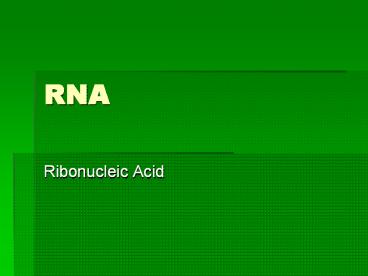RNA - PowerPoint PPT Presentation
1 / 20
Title:
RNA
Description:
RNA Ribonucleic Acid Structure of RNA Single stranded Ribose Sugar 5 carbon sugar Phosphate group Adenine, Uracil, Cytosine, Guanine Types of RNA Three main types ... – PowerPoint PPT presentation
Number of Views:973
Avg rating:3.0/5.0
Title: RNA
1
RNA
- Ribonucleic Acid
2
Structure of RNA
- Single stranded
- Ribose Sugar
- 5 carbon sugar
- Phosphate group
- Adenine, Uracil, Cytosine, Guanine
3
Types of RNA
- Three main types
- Messenger RNA (mRNA) transfers DNA code to
ribosomes for translation. - Transfer RNA (tRNA) brings amino acids to
ribosomes for protein synthesis. - Ribosomal RNA (rRNA) Ribosomes are made of rRNA
and protein.
4
Transcription
- RNA molecules are produced by copying part of the
nucleotide sequence of DNA into complementary
sequence in RNA, a process called transcription. - During transcription, RNA polymerase binds to DNA
and separates the DNA strands. RNA polymerase
then uses one strand of DNA as a template from
which nucleotides are assembled into a strand of
mRNA.
5
mRNA
6
How Does it Work?
- RNA Polymerase looks for a region on the DNA
known as a promoter, where it binds and begins
transcription. - RNA strands are then edited. Some parts are
removed (introns) - which are not expressed and
other that are left are called exons or expressed
genes.
7
The Genetic Code
- This is the language of mRNA.
- Based on the 4 bases of mRNA.
- Words are 3 RNA sequences called codons.
- The strand aaacguucgccc would be separated as
aaa-cgu-ucg-ccc the amino acids would then be
Lysine Arginine Serine - Proline
8
Genetic Codes
9
Translation
- During translation, the cell uses information
from messenger RNA to produce proteins. - A Transcription occurs in nucleus.
- B mRNA moves to the cytoplasm then to the
ribosomes. tRNA read the mRNA and obtain the
amino acid coded for. - C Ribosomes attach amino acids together forming
a polypeptide chain. - D Polypeptide chain keeps growing until a stop
codon is reached.
10
Translation to Protein
11
Translation
12
Mutations
- Gene mutations result from changes in a single
gene. Chromosomal mutations involve changes
whole chromosomes.
13
Gene Mutation
- Point Mutation Affect one nucleotide thus
occurring at a single point on the gene. Usually
one nucleotide is substituted for another
nucleotide. - Frameshift Mutation Inserting an extra
nucleotide or deleting a nucleotide causes the
entire code to shift.
14
Gene Mutation
15
Chromosomal Mutations
- Deletion Part of a chromosome is deleted
- Duplication part of a chromosome is duplicated
- Inversion chromosome twists and inverts the
code. - Translocation Genetic information is traded
between nonhomologous chromosomes.
16
Chromosomal Mutations
17
Mutations
18
More Mutations
19
Gene Regulation
- In simple cells (prokaryotic) lac genes which are
controlled by stimuli, turn genes on and off. - In complex cells (eukaryotic) this process is not
as simple. Promoter sequences regulate gene
operation.
20
Review






























